Density is a substance's mass per unit of volume. The symbol most often used for density is ρ, although the Latin letter D can also be used. Mathematically, density is defined as mass divided by volume:
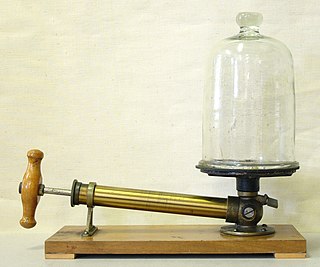
A vacuum is space devoid of matter. The word is derived from the Latin adjective vacuus meaning "vacant" or "void". An approximation to such vacuum is a region with a gaseous pressure much less than atmospheric pressure. Physicists often discuss ideal test results that would occur in a perfect vacuum, which they sometimes simply call "vacuum" or free space, and use the term partial vacuum to refer to an actual imperfect vacuum as one might have in a laboratory or in space. In engineering and applied physics on the other hand, vacuum refers to any space in which the pressure is considerably lower than atmospheric pressure. The Latin term in vacuo is used to describe an object that is surrounded by a vacuum.

A calorimeter is a device used for calorimetry, or the process of measuring the heat of chemical reactions or physical changes as well as heat capacity. Differential scanning calorimeters, isothermal micro calorimeters, titration calorimeters and accelerated rate calorimeters are among the most common types. A simple calorimeter just consists of a thermometer attached to a metal container full of water suspended above a combustion chamber. It is one of the measurement devices used in the study of thermodynamics, chemistry, and biochemistry.

Humidity is the concentration of water vapor present in the air. Water vapor, the gaseous state of water, is generally invisible to the human eye. Humidity indicates the likelihood for precipitation, dew, or fog to be present.

Lung volumes and lung capacities refer to the volume of air in the lungs at different phases of the respiratory cycle.
In physiology, body water is the water content of an animal body that is contained in the tissues, the blood, the bones and elsewhere. The percentages of body water contained in various fluid compartments add up to total body water (TBW). This water makes up a significant fraction of the human body, both by weight and by volume. Ensuring the right amount of body water is part of fluid balance, an aspect of homeostasis.
Penile plethysmography (PPG) or phallometry is a measurement of blood flow to the penis, typically used as a proxy for measurement of sexual arousal. The most commonly reported methods of conducting penile plethysmography involves the measurement of the circumference of the penis with a mercury-in-rubber or electromechanical strain gauge, or the volume of the penis with an airtight cylinder and inflatable cuff at the base of the penis. Corpora cavernosa nerve penile plethysmographs measure changes in response to inter-operative electric stimulation during surgery. The volumetric procedure was invented by Kurt Freund and is considered to be particularly sensitive at low arousal levels. The easier to use circumferential measures are more widely used, however, and more common in studies using erotic film stimuli. A corresponding device in women is the vaginal photoplethysmograph.

The diving reflex, also known as the diving response and mammalian diving reflex, is a set of physiological responses to immersion that overrides the basic homeostatic reflexes, and is found in all air-breathing vertebrates studied to date. It optimizes respiration by preferentially distributing oxygen stores to the heart and brain, enabling submersion for an extended time.

A plethysmograph is an instrument for measuring changes in volume within an organ or whole body. The word is derived from the Greek "plethysmos", and "graphein".
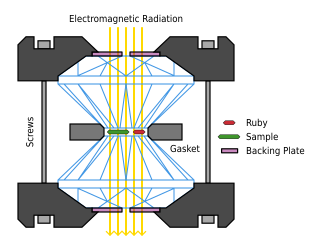
A diamond anvil cell (DAC) is a high-pressure device used in geology, engineering, and materials science experiments. It permits the compression of a small (sub-millimeter-sized) piece of material to extreme pressures, typically up to around 100–200 gigapascals, although it is possible to achieve pressures up to 770 gigapascals.
Optoelectronic plethysmography is a method to evaluate ventilation through an external measurement of the chest wall surface motion.
The body fat percentage (BFP) of a human or other living being is the total mass of fat divided by total body mass, multiplied by 100; body fat includes essential body fat and storage body fat. Essential body fat is necessary to maintain life and reproductive functions. The percentage of essential body fat for women is greater than that for men, due to the demands of childbearing and other hormonal functions. Storage body fat consists of fat accumulation in adipose tissue, part of which protects internal organs in the chest and abdomen. A number of methods are available for determining body fat percentage, such as measurement with calipers or through the use of bioelectrical impedance analysis.
In physical fitness, body composition refers to quantifying the different components of a human body. The selection of compartments varies by model but may include fat, bone, water, and muscle. Two people of the same gender, height, and body weight may have completely different body types as a consequence of having different body compositions. This may be explained by a person having low or high body fat, dense muscles, or big bones.
Bioelectrical impedance analysis (BIA) is a method for estimating body composition, in particular body fat and muscle mass, where a weak electric current flows through the body, and the voltage is measured in order to calculate impedance of the body. Most body water is stored in muscle. Therefore, if a person is more muscular, there is a high chance that the person will also have more body water, which leads to lower impedance. Since the advent of the first commercially available devices in the mid-1980s the method has become popular, owing to its ease of use and portability of the equipment. It is familiar in the consumer market as a simple instrument for estimating body fat. BIA actually determines the electrical impedance, or opposition to the flow of an electric current through body tissues, which can then be used to estimate total body water (TBW), which can be used to estimate fat-free body mass and, by difference with body weight, body fat.
Normal human body temperature is the typical temperature range found in humans. The normal human body temperature range is typically stated as 36.5–37.5 °C (97.7–99.5 °F).
Hydrostatic weighing, also referred to as underwater weighing, hydrostatic body composition analysis and hydrodensitometry, is a technique for measuring the density of a living person's body. It is a direct application of Archimedes' principle, that an object displaces its own volume of water.
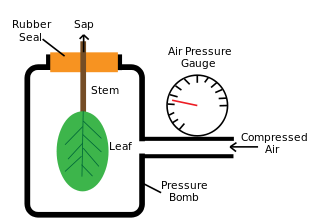
A pressure bomb, pressure chamber, or Scholander bomb is an instrument that can measure the approximate water potential of plant tissues. A leaf and petiole or stem segment is placed inside a sealed chamber. Pressurized gas is slowly added to the chamber. As the pressure increases, at some point the liquid contents of the sample will be forced out of the xylem and will be visible at the cut end of the stem or petiole. The pressure that is required to do so is equal and opposite to the water potential of the sample. Pressure bombs are field portable and mechanically simple, which make them the predominant method for water potential measurements in the fields of plant physiology and ecophysiology.

Obesity classification is a ranking of obesity, the medical condition in which excess body fat has accumulated to the extent that it has an adverse effect on health. The World Health Organization (WHO) classifies obesity by body mass index (BMI). BMI is further evaluated in terms of fat distribution via the waist–hip ratio and total cardiovascular risk factors. In children, a healthy weight varies with age and sex, and obesity determination is in relation to a historical normal group.
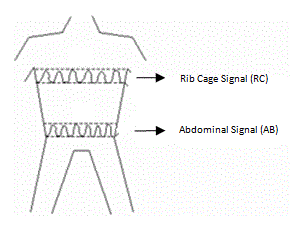
Respiratory inductance plethysmography (RIP) is a method of evaluating pulmonary ventilation by measuring the movement of the chest and abdominal wall.
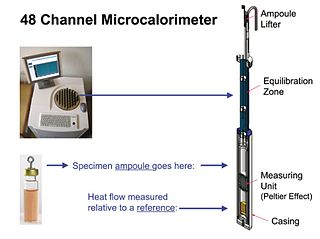
Isothermal microcalorimetry (IMC) is a laboratory method for real-time monitoring and dynamic analysis of chemical, physical and biological processes. Over a period of hours or days, IMC determines the onset, rate, extent and energetics of such processes for specimens in small ampoules at a constant set temperature.












